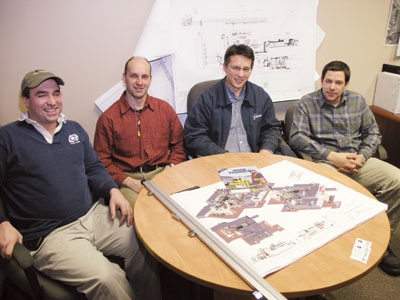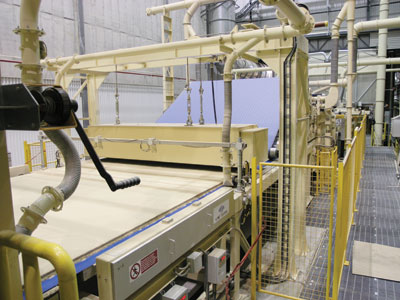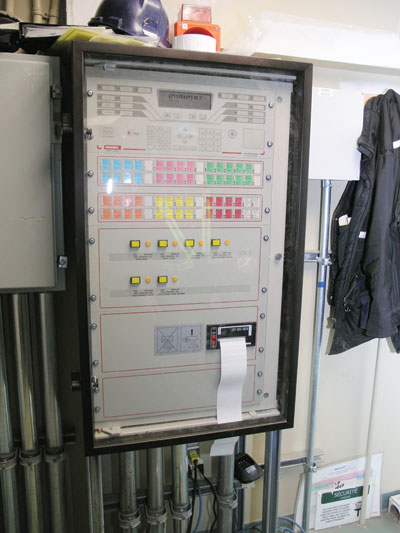
Features
Site Visit
Wood Panels
Pressing Ahead
As its staff sifted through the ashes on April 18, 2006, the future for Tafisa Canada’s particleboard plant in Lac-Mégantic, QC, must have seemed dim. The day prior a spark in a system serving Line 2 turned into an explosion, and then a rapidly spreading fire. In the end, Line 2, the newest line responsible for 65% of the plant’s output, was destroyed, and Line 1 would be out of service for two months. Only the company’s melamine lines were operating, but they would soon run out of in-house raw board to process.
November 28, 2011 By Scott Jamieson
 Part of the Tafisa Canada Line 2 project team (from left): Stéphane Boucher (process manager) As its staff sifted through the ashes on April 18
Part of the Tafisa Canada Line 2 project team (from left): Stéphane Boucher (process manager) As its staff sifted through the ashes on April 18In one fell swoop, 10% of North America’s particleboard production was off line, and 350 employees feared for their futures.
“Those were tough days,” recalls Tafisa Canada CEO Louis Brassard. “We had nothing to sell our clients, which is not good for market share, and our fibre suppliers had to go elsewhere. We really didn’t know what our future was. All of that goes through an employee’s mind at a time like this. In the end, Tafisa decided to re-invest here, putting faith in the market, the community, and our employees.”
Then came the hard part – actually rebuilding an industrial complex from the ground up, an 18-month project requiring over 435,000 man hours and a peak construction crew of over 400. The first board was pressed on Dec. 21, 2007, and Canadian Wood Products sat down with the core project team early in 2008 to discuss the design process, the new plant, and what it means to rebuild North America’s largest particleboard complex after a devastating fire.
Built on the Past
The Tafisa Canada Line 2 project team includes Daniel Bombardier, vice-president operations; Stéphane Boucher, process manager; Stéphane Poirier, engineering manager, and Roger Orichefqui, raw board production manager. They received engineering support from Sandwell EPC, and construction site management from L Nardella Associates.
“Really, we started the re-design and rebuild with just one key constraint,” explains Poirier. “To save time and money, we opted to put all the equipment back in the same footprint.”
Not surprisingly, a major objective was to make the safest plant possible, and to that end Tafisa contracted Professional Loss Control (PLC) to review the proposed design, ensuring it met National Fire Code of Canada (NFC) as well as applicable National Fire Protection Agency (NFPA) standards and guides (see box on page 14 for safety details).
With few key exceptions, such as dust collection, the actual systems suppliers remained the same as on the original line. Yet equipment was updated to the newest generation, a few new pieces of equipment were added to remove production bottlenecks in the original line, and changes were made to eliminate production hurdles or maintenance headaches. Management feels the result is a state-of-the-art mill that will handily out-produce the old one, itself a modern line built in 2000.
“We knew from experience running the original Line 2 that we could improve uptime and throughput, and reduce maintenance costs,” says Bombardier. “Stéphane Boucher had worked on the production side, and knew first-hand some of the challenges with the old line. He was intimately involved in designing the new production flow and in choosing equipment. He also had the chance to visit many of our company’s plants around the world, to help them on projects like reducing glue consumption, so came back with best practices that were included in the design. In the end, we’ve got a line with the same dimensions and theoretical design capacity as the original line, but we expect to get more production from it at the end of the day.”
Certainly it’s rare to get a second chance at designing your mill just a few years after startup, and Tafisa hopes it has taken full advantage of the opportunity. Of course, wood products professionals know too well to expect the unexpected. Engineer Stéphane Poirier’s background is in the sawmilling side, where if something can go wrong, it will. So he adds a note of caution as we turn to discuss the new production flow.
“We’ve worked hard to remove any problems with the old line, and I think we’ve succeeded,” he says with a sly smile. “Now we’ll see if we’ve introduced some new ones.”
Fibre Challenges
Production starts in the large fibre yard, where some 250 different suppliers converge with a range of sawdust, wood chips, and recycled wood. For its annual capacity of 968,000 m3 (547 million ft2 – 3/4″ basis), the two line plant needs roughly 677,600 tonnes of raw material. Securing this was among the first challenges Tafisa faced as it prepared to ramp up production in the fall of 2007. Suppliers tend to move on during an 18-month hiatus, and a struggling sawmill sector and burgeoning bioenergy market in Quebec and the northeastern US don’t make things easier, Bombardier says.
“Yes, the bioenergy sector is something we need to consider, as government seems keen to promote it. One way is to make sure the right fibre goes to the highest end user, and to that end we signed a recycled fibre supply agreement with Kruger this past fall. We get the Class A fibre we need to make good board, and they get the Class B fibre for their co-gen facility (Bromptonville, QC). Bioenergy is a fine thing, but to us it’s still better to make furniture rather than burn the fibre.”
This is true from both an employment and value-added perspective. It also makes sense from the increasingly important carbon balance perspective, as the furniture or kitchen cabinet Tafisa makes will lock carbon away for decades rather than the minutes it takes sawdust to go up in smoke.
Another piece to the raw fibre puzzle, and another green feather in Tafisa’s cap, is the plant’s recycled wood, or “Rewood” processing facility. While uncommon among North American board plants, it is a regular feature at the company’s European plants and Tafisa Canada had experimented with the concept for a year prior to the explosion.
The Rewood plant accepts material from construction and demolition sites, as well as pallet manufacturers like Bois Laurentian (see CWP Jan/Feb 08 or visit www.canadianwoodproducts.ca for a story on its waste wood processing). The material comes to Tafisa already hogged, and is then fed through a series of screening, hammer-milling, metal removal, and refining equipment before being sent to the production line. The mill has also added Acrowood DiamondRoll screens in an effort to reduce downtime.
“We had some issues in the past with very long pieces jamming up the process,” recalls Orichefqui. “These have been added to deal with that. They also allow existing fines to drop out of the process at this stage rather than continuing on through the process and wasting refining capacity.”
After metal and non-metal separators (non-metal to remove impurities like aluminum, which can become dangerous hot bodies if left in the fibre), and Pallman refiners fitted with hammermill sections, Rewood fibre is sent to dedicated storage silos so the recycled content can be managed. With adequate supplies, Rewood could represent up to 20% of Line 2’s raw material, but Orichefqui says that level will be attained slowly, and carefully.
“I think we’ve solved a lot of problems with our new Rewood design. When you buy recycled wood, you have to accept everything, and it’s very dry. You have to be able to handle it all efficiently, and safely. I think we can, so now the key is to monitor its effect on the board quality and downstream production carefully, and increase the Rewood content over time.”
The main fibre supply comes from area sawmills and is dumped into large inside storage areas. The conveyor system ensures good rotation, sending material to Pallman refiners according to the board recipe. Four refiners handle the chips, two the sawdust, with refined material going to silos. In all there are four SHW silos ahead of the two Buttner dryers – One for chips (hardwood and softwood), and this larger material will mainly make up the board’s core; one for sawdust, smaller material mostly for the board’s surface; one for Rewood material; and the last for fibre that has been reclaimed in the process.
The dryers are similar to the original line, and are fed by a GTS energy system fed by wood waste and a dust burner, with #2 oil as a rarely used back-up. However the dryers are fitted with larger capacity fans to remove a former bottleneck.
“We have already pushed the dryers hard,” Orichefqui says, “and it seems like we have plenty of capacity now.”
Off gases from the dryers are treated by a United McGill wet ESP, one of the few systems to have survived the fire. Still, Bombardier notes that sitting idle for a winter was not kind to the emission control system, requiring some extensive maintenance before it could go back on line.
Of course the entire dust collection and conveying system had to be re-built, and this time Tafisa went with a Rodrigue Metal (Rodair) system, fitted with 94 Grecon spark detectors/extinguisher modules (see box on safety on page 14). Baghouses were also changed from mechanical blowers to pneumatic systems, reducing the fire risk further. Orichefqui adds that maintenance and access have also been improved with the new system.
Better Screening
After drying, fibre goes to four Imal-PAL double shaker screens, isolated inside a sealed room with ceiling venting to reduce the fire risk. From here, fines go to a baghouse, then another SHW silo for dry fuel, and then to the dust burner. The remaining fibre is sorted into surface layer, core, and oversized, although the sorting point for each can be adjusted as required.
“A 1.5-in board will be 75% core, while a 1/4-in board will be 55% core, so we have to be able to play with the screens here to get the balance we need,” explains Orichefqui.
Tafisa then uses Imal-PAL “wind sifters”, a form of pneumatic weight separator to remove oversized material and small rocks, adding another quality step in the process. Two wind sifters handle core material, not an unusual step for most modern mills, but Tafisa is also using two wind sifters for surface material and one for oversized material.
“Not many plants have this equipment for the surface layer, and it gives us a very good chance to separate the really big particles and the fine rocks. When you have the fine rocks – more like sand really – in the surface, it’s very hard to remove. The wind sifters do that for us ahead of time.”

Next come two SHW dry silos for core and surface material, followed by a pair of Imal blenders fed by a well designed Imal glue kitchen. S. Huot conveying systems ferry material to the forming line, which is a tropical version of CMC-Texpan’s popular forming system, designed to handle higher humidity levels. The crown former replaces the original cage-style former, and includes magnets to remove tramp metal ahead of the pre-press. A Grecon matt gauge handles on-line process and quality control ahead of the press. The Siempelkamp ContiRoll press is the same dimension as before – 10′ x 38.7 m – but Boucher notes that it has the supplier’s latest enhancements.

“It’s a new generation Siempelkamp, and they’ve included many improvements – more flexibility for board control, better heat transfer from the press to the board, etc…”
Tafisa also upgraded the press emission control system, now a Scheuch ESAP system, complete with an integrated ESP module for final treatment. Extraction hoods collect press-off gases, where water is injected for primary cleaning. The process water then goes to water cleaning modules, while the remaining gas goes to the Scheuch WESP. The 55,000 cfm system is a major upgrade over the original 7,000 cfm system.
The press section also boasts a state-of-the-art Flamex Minifog (Minimax) fire protection system to identify and quickly extinguish fire risks using a minimal amount of water to reduce any resulting damage or downtime.
More changes can be seen at the press outfeed, where the belt conveyor has been replaced by rollers to avoid slippage when the conveyor heats up. Process and quality control after the press includes a Grecon blister detector, thickness gauge, and Siempelkamp’s own non-contact scale, with highly accurate readings at five points across the board.
“We have all the control technology required to put the line at very high speeds without risking quality, and the heat transfer rate and controls in the new press allow us to do just that,” Boucher says of the new press section.
Tafisa has taken steps to make sure the peripheral support systems can keep pace with the new press. For example, slow-speed, high-torque screw conveyors from local supplier Continental Conveyors have replaced many of the belt conveyors formerly used. This is expected to reduce both cleaning requirements and downtime. Another example is the dust-conveying system, which features reinforced elbows in areas where the old systems saw excessive wear.
“Basically, we looked at the old plant, and everywhere we saw excess wear or repetitive maintenance or downtime, we made it more robust or invested a little more in the equipment to avoid it,” says Poirier.
Overall, the more reliable, more robust, and distinctly safer plant is an investment that reflects the company’s confidence in the North American market, the local workforce in Lac-Mégantic, and the new line’s ability to produce top-end board.
“One good thing about the fire is that it forced us to go to the open market for raw board to feed our four melamine lines,” concludes CEO Brassard. “So we know what’s available, the sizes and quality, and we also know there is a place in the market for a plant like this, with our range of sizes, the surface we produce, and the consistent quality. I think we have a winning formula.”
Once burned, twice shy
The explosion and ensuing fire on April 17, 2006, destroyed Line 2 just six years after the 10-ft line was commissioned, and shut Line 1, a nine-foot line, down for two months. Yet miraculously no one suffered any life-threatening injuries. That doesn’t mean the plant staff, management, or CSST (Quebec’s WCB) want to go through it again anytime soon, so the new line Line 2 has been designed to prevent explosions and the spread of fire, from the ground all the way up to its very busy roof.
From Day One in the design process, Tafisa Canada involved a loss control expert, whose role was to identify risk areas and help include explosion and fire prevention into the design and equipment selection. Examples of this vigilant approach include:
• The use of 94 Grecon spark detection and extinguishing systems in the fibre prep area alone, versus 35 prior. The supplier worked extensively with Tafisa and regulators to meet Canadian safety standards. A fair number of zones feature ATEX approved explosion proof systems, and inter-zone communications have been improved through the whole system.
• Moving as many potentially hazardous systems as possible up to the roof and outside the building, ensuring that any explosive gases vent to the atmosphere. In fact, with so many systems outside, the roof top now looks like a mini-city from a distance.
• Where putting systems outside was not an option, gases are vented outside and/or the systems are isolated from the main plant (i.e., the Imal/Pal shaker screens).
• Venting panels are integrated in external walls in high-risk areas.

• Flamex MiniFog (MiniMax) multi-zone fire detection system used at the press, a system that not only detects fires accurately, but uses a minimal amount of water to extinguish the threat, thus reducing potential damage to costly press gear.
• Compartmentalized design, with different areas sealed off from one another rather than the wide open plant design many are used to.
• Design features that minimize the collection of dust, thus reducing the threat that fires will spread quickly. This includes cable trays and trusses oriented vertically to allow dust to fall to the floor. Easy-access vacuum systems can then be used to clean up areas where dust still collects.
• Enhanced fire brigade and response system in the event of a fire.
“We’ve invested a lot to meet 2007 NFPA standards,” says Bombardier. Still, as Poirier stresses, the precautionary measures are indeed an investment that will eventually pay off in spades.
“Does all this add cost? Some of it, like the focus on making the plant easier to clean, will actually save money. But, yes, some of it adds cost, there’s no doubt. That is until you have a fire, and then the ROI on this will be pretty quick.”
Print this page